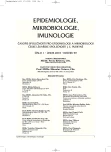Exotic Pets as a Potential Source of Salmonella
Authors:
H. Kocianová 1; S. Litvová 1; M. Štefkovičová 1; D. Gavačová 2; I. Rovný 2; L. Glosová 3; H. Hudečková 4
Authors place of work:
Regionálny úrad verejného zdravotníctva so sídlom v Trenčíne
1; Úrad verejného zdravotníctva Slovenskej republiky
2; Fakultná nemocnica Trenčín
3; Ústav verejného zdravotníctva JLF UK Martin
4
Published in the journal:
Epidemiol. Mikrobiol. Imunol. 59, 2010, č. 1, s. 9-12
Summary
Study aim:
To clarify the source of infection with the exotic serovar Salmonella Urbana and the route of transmission in a 2-year-old child.
Material and methods:
To identify the source of infection and the route of transmission, we used epidemiological investigation of the case of salmonellosis and microbiological methods for the detection of Salmonella from biological specimens, epidemiologically suspected food, turtle tank water and feed, and serotyping of isolated strains of Salmonella.
Results:
Salmonella Urbana was confirmed in a rectal swab of the infected child and in a sample of turtle tank water. Laboratory analyses of farm eggs eaten by the investigated family, of rectal swabs of the other family members and of a turtle feed sample did not reveal the presence of salmonellae.
Conclusion:
The confirmed source of Salmonella infection caused by the exotic serovar Salmonella Urbana in a two-year-old child were pet water turtles. In the case of the isolation of exotic serovars of Salmonella, the epidemiological and laboratory investigation needs to be aimed at the contact with pet animals, especially reptiles. It is desirable to raise the awareness of both the public and health professionals of this issue.
Key words:
salmonellosis, Salmonella Urbana, water turtles, reptiles.
Zdroje
1. Barták, P., Čížek, A. Salmonelózy plazů. Veterinářství, 1987, 37, 12, 554-556.
2. Bertrand, S., Rimhanen-Finne, R., Weill, F.X., Rabsch, W., Thornton, l., et al. Euro Surveill., 2008, 13, 24, 264-269.
3. CDC. Turtle-associated salmonellosis in humans-United States, 2006-2007. MMWR Morb Mortal Wkly Rep., 2007, 56, 26, 649-652.
4. CDC. Multistate outbreak of human Salmonella infections associated with exposure to turtles–United States, 2007-2008. MMWR Morb Mortal Wkly Rep., 2008, 57, 3, 69-72.
5. de Jong, B., Andersson, Y., Ekdahl, K. Effect of regulation and education on reptile -associated salmonellosis. Infect Dis, 2005, 11, 3, 398-403.
6. Gaertner, J.P., Hahm, D., Rose, F.L., Forstner, M.R. Detection of salmonellae in different turtle species within a headwater spring ecosystem. J Wildl Dis, 2008, 44, 2, 519-526.
7. Kourany, M., Myers, C.W., Schneider, C.R. Panamanian amphibians and reptiles as carriers of Salmonella. Am J Trop Med Hyg, 1970, 19, 4, 632-638.
8. Lamm, S.H., Taylor, A., Jr., Gangarosa, J., Andderson, et al. Turtle-associated salmonellosis. I. An estimation of the magnitude of the problem in the United States, 1970-1971. Am J Epidemiol, 1972, 95, 6, 511-517.
9. Mermin, J., Hutwagner, L., Vugia, D., et al. Reptiles, amphibians, and human Salmonella infection: a population-based, case-control study. Clin Infect Dis, 2004, 38, 3, 253-561.
10. Minami, K., Yanagawa, T., Okuda, M., Suzuki, H., et al. Cerebrospinal fluid cytokines in Salmonella Urbana encephalopathy. Tohoku J Exp Med., 2004, 203, 2, 129-132.
11. Wells, E.V., Boultonm M., Hallm W., Bidol, S.A. Reptile-associated salmonellosis in preschool-aged children in Michigan, January 2001-June 2003. Clin Infect Dis, 2004, 39, 5, 687-691.
Štítky
Hygiena a epidemiológia Infekčné lekárstvo MikrobiológiaČlánok vyšiel v časopise
Epidemiologie, mikrobiologie, imunologie

2010 Číslo 1
- Parazitičtí červi v terapii Crohnovy choroby a dalších zánětlivých autoimunitních onemocnění
- Očkování proti virové hemoragické horečce Ebola experimentální vakcínou rVSVDG-ZEBOV-GP
- Koronavirus hýbe světem: Víte jak se chránit a jak postupovat v případě podezření?
Najčítanejšie v tomto čísle
- Životní jubileum prof. MUDr. Vladimíra Janouta, CSc.
- Nocardia farcinica jako původce abscesu mozku u pacienta s intersticiálním onemocněním plic
- Výskyt tularémie na Slovensku v rokoch 1997 – 2008
- Exotickí domáci miláčikovia ako potenciálny zdroj salmonel
